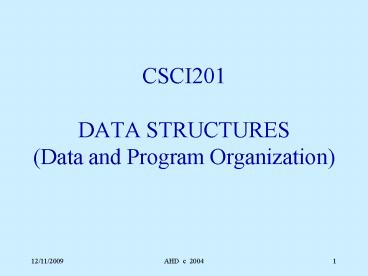CSCI201 DATA STRUCTURES Data and Program Organization - PowerPoint PPT Presentation
1 / 37
Title:
CSCI201 DATA STRUCTURES Data and Program Organization
Description:
A binary tree is a tree in which no node can have more than two children. ... Obtain the infix form of an expression. Obtain the prefix form of an expression. ... – PowerPoint PPT presentation
Number of Views:23
Avg rating:3.0/5.0
Title: CSCI201 DATA STRUCTURES Data and Program Organization
1
CSCI201 DATA STRUCTURES(Data and Program
Organization)
2
- Binary Tree
- Properties and Representation
3
Definition of a Binary Tree
- A binary tree is a tree in which no node can
have more than two children. Because there are
only two children we name them left and right.
4
Recursive Definition of a Binary Tree
- A binary tree is either empty or consists of a
root, a left tree and a right tree. The left and
right trees may themselves be empty. Thus a node
with one child could have a left or a right child.
5
(No Transcript)
6
(No Transcript)
7
An expression tree such as this one is an
essential data structure in compiler design.
8
(No Transcript)
9
(No Transcript)
10
Binary Tree Properties Representation
11
Minimum Number Of Nodes in a Binary Tree
minimum number of nodes of a binary tree of
height h is h 1
12
Maximum Number Of Nodes
Maximum number of nodes (N) in a binary tree is
2h1 - 1 For a height h of 3, N 1 2 4 8
15 ( 24 - 1)
13
Number Of Nodes Height
- Let n be the number of nodes in a binary tree
whose height is h. - h1 lt n lt 2h1 1
- i.e. the value of n lies between the minimum
h1 and the maximum 2h1 1 - log2(n1) lt h1 lt n
- e.g. for n 7, then log2(8) height of 2
for a balanced binary tree, or height 6 for
binary tree where each node has only one child .
. .
14
The Logarithm
- 2x n
- 23 8
- log28 3
- When logarithms are used in computer science,
the base is always 2. Note, the log base 2 of a
number always results in a smaller number.
15
Balanced complete binary tree. n 7, h 2
16
Unbalanced complete binary tree. n 6, h 2
17
Unbalanced incomplete binary tree. n 6, h 2
18
Right-skewed binary tree. n 7, h 6
19
Full Binary Tree
- A full binary tree of a given height h has 2h1
1 nodes.
20
Numbering Nodes In A Full Binary Tree
- Number the nodes 1 through 2h1 1.
- Number by levels from top to bottom.
- Within a level number from left to right.
1
2
3
4
6
5
7
8
9
10
11
12
13
14
15
21
Node Number Properties
- Parent of node i is node i / 2, unless i 1.
- Node 1 is the root and has no parent.
22
Node Number Properties
- Left child of node i is node 2i, unless 2i gt n,
where n is the number of nodes. - If 2i gt n, node i has no left child.
23
Node Number Properties
- Right child of node i is node 2i1, unless 2i1 gt
n, where n is the number of nodes. - If 2i1 gt n, node i has no right child.
24
Complete Binary Tree With n Nodes
- Start with a full binary tree that has at least n
nodes. - Number the nodes as described earlier.
- The binary tree defined by the nodes numbered 1
through n is the unique n node complete binary
tree.
25
Example
- Complete binary tree with 10 nodes.
26
Example
- Complete binary tree with 15 nodes.
27
Binary Tree Representation
- Array representation.
- Linked representation.
28
Array Representation
- Number the nodes using the numbering scheme for a
full binary tree. The node that is numbered i is
stored in treei.
a
b
c
d
e
f
g
h
i
j
29
Right-Skewed Binary Tree
- An n node binary tree needs an array whose length
is between n1 and 2n.
30
Linked Representation
- Each binary tree node is represented as an object
whose data type is BinaryTreeNode. - The space required by an n node binary tree is n
(space required by one node).
31
The Class BinaryTreeNode
- package dataStructures
- public class BinaryTreeNode
- Object element
- BinaryTreeNode leftChild // left subtree
- BinaryTreeNode rightChild// right subtree
- // constructors and any other methods
- // come here
32
Linked Representation Example
33
Some Binary Tree Operations
- Determine the height.
- Determine the number of nodes.
- Make a clone.
- Determine if two binary trees are clones.
- Display the binary tree.
- Evaluate the arithmetic expression represented by
a binary tree. - Obtain the infix form of an expression.
- Obtain the prefix form of an expression.
- Obtain the postfix form of an expression.
34
Binary Tree Traversal
- Many binary tree operations are done by
performing a traversal of the binary tree. - In a traversal, each element of the binary tree
is visited exactly once. - During the visit of an element, all action (make
a clone, display, evaluate the operator, etc.)
with respect to this element is taken.
35
Binary Tree Traversal Methods
- Preorder
- Inorder
- Postorder
- Level order
36
- End of BinaryTrees.ppt
37
- Last Updated Friday 1st October 2004, 954 PT,
AHD































